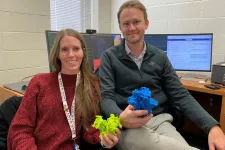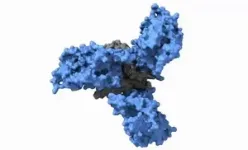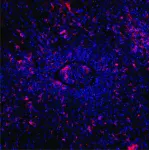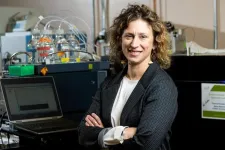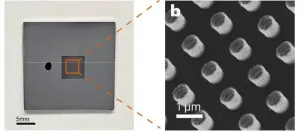(Press-News.org) DURHAM, N.C. – As the HIV virus glides up outside a human cell to dock and possibly inject its deadly cargo of genetic code, there’s a spectacularly brief moment in which a tiny piece of its surface snaps open to begin the process of infection.
Seeing that structure snap open and shut in mere millionths of a second is giving Duke Human Vaccine Institute (DHVI) investigators a new handle on the surface of the virus that could lead to broadly neutralizing antibodies for an AIDS vaccine. Their findings appear Feb. 2 in Science Advances.
Being able to attach an antibody specifically to this little structure that would prevent it from popping open would be key. Their findings appear Feb. 2 in Science Advances.
The moving part is a structure called envelope glycoprotein, and AIDS researchers have been trying to figure it out for years because it is a key part of the virus’ ability to dock on a T-cell receptor known as CD4. Many parts of the envelope are constantly moving to evade the immune system, but vaccine immunogens are designed to stay relatively stable.
“Everything that everybody's done to try to stabilize this (structure) won't work, because of what we learned,” said lead author Rory Henderson, a structural biologist who is an associate professor of medicine in DHVI. “It’s not that they did something wrong; it's just that we didn't know it moves this way.”
Postdoctoral researcher and study co-author Ashley Bennett offers a play-by-play: As the virus feels for its best attachment point on a human T-cell, the host cell’s CD4 receptor is the first thing it latches onto. That connection is what then triggers the envelope structure to pop open, which in turn, exposes a co-receptor binding site “and that’s the event that actually matters.”
Once both molecules of the virus are bound to the cell membrane, the process of injecting viral RNA can begin. “If it gets inside the cell, your infection is now permanent,” Henderson said.
“If you get infected, you’ve already lost the game because it’s a retrovirus,” Bennett agrees.
The moving structure they found protects the sensitive co-receptor binding site on the virus. “It's also a latch to keep it from springing until it's ready to spring,” Henderson said. Keeping it latched with a specific antibody would stop the process of infection.
To see the viral parts in various states of open, closed and in-between, Bennett and Henderson used an electron accelerator at the Argonne National Laboratory outside Chicago that produces X-rays in wavelengths that can resolve something as small as a single atom. But this expensive, shared equipment is in high demand. The AIDS researchers were awarded three 120-hour blocks of time with the synchrotron to try to get as much data as they could in marathon sessions. “Basically, you just go until you can’t anymore,” Bennett said.
Earlier research elsewhere had argued that antibodies were being designed for the wrong shapes on the virus and this work shows that was probably correct.
“The question has been ‘why, when we immunize, are we getting antibodies to places that are supposed to be blocked?’” Henderson said. Part of the answer should lie in this particular structure and its shape-shifting.
“It’s the interplay between the antibody binding and what this shape is that's really critical about the work that we did,” Henderson said. “And that led us to design an immunogen the day we got back from the first experiment. We think we know how this works.”
This research was supported by the National Institutes of Health (UM1AI14437, R01AI145687, U54AI170752, P30 GM124169, S10OD018483), the Department of Energy (DE-AC02-06CH11357) and the DOE Office of Biological and Environmental Research.
CITATION: “Microsecond Dynamics Control the HIV-1 Envelope Conformation,” Ashley L. Bennett, R.J. Edwards, Irina Kosheleva, Carrie Saunders, Yishak Bililign, Ashliegh Williams, Pimthada Bubphamala, Katayoun Manosouri, Kara Anasti, Kevin O. Saunders, S. Munir Alam, Barton F. Haynes, Priyamvada Acharya, Rory Henderson. Science Advances, Feb. 2, 2024. DOI: 10.1126/sciadv.adj0396
END
Scientists see an ultra-fast movement on surface of HIV virus
Antibodies aimed at this moving part could be key to a new vaccine approach
2024-02-02
ELSE PRESS RELEASES FROM THIS DATE:
Gene editing precisely repairs immune cells
2024-02-02
Some hereditary genetic defects cause an exaggerated immune response that can be fatal. Using the CRISPR-Cas9 gene-editing tool, such defects can be corrected, thus normalizing the immune response, as researchers led by Klaus Rajewsky from the Max Delbrück Center now report in “Science Immunology.”
Familial hemophagocytic lymphohistiocytosis (FHL) is a rare disease of the immune system that usually occurs in infants and young children under the age of 18 months. The condition is severe and has a high mortality rate. It is caused by various gene mutations that prevent cytotoxic T cells from functioning normally. These ...
COPD: The effect of low-dose cadmium, a highly toxic metal, on airway epithelial cells
2024-02-02
BIRMINGHAM, Ala. – Cigarette smoke exposure is associated with the development and severity of chronic obstructive pulmonary disease, or COPD, which is the third leading cause of death worldwide.
Cigarette smoke contains 2 to 3 micrograms of cadmium, a highly toxic metal and environmental pollutant, per cigarette. Burning tobacco releases cadmium oxide that can be adsorbed onto microparticles in smoke that travel deep into the lungs. Furthermore, the body is not able to remove cadmium, which accumulates in longtime smokers.
In ...
Regulation makes crypto markets more efficient
2024-02-02
First-of-its-kind research on cryptocurrency finds that the most regulated coins create the most efficient markets.
That crypto regulation, often provided by cryptocurrency exchanges like Binance, can also help protect investors by providing reliable, public information.
“Both small and institutional investors should know, if they invest in coins without any regulation, they may suffer from price manipulation or a severe lack of insider information,” said Liangfei Qiu, a University of Florida professor of business and one of the authors of the new study.
“Instead, they may want to invest in coins listed with platforms ...
Centuries-old texts penned by early astronomers Copernicus and Sacrobosco find new home at RIT
2024-02-02
The ancient astronomer Nicolaus Copernicus was the first scientist to document the theory that the sun is the center of the universe in his book, De Revolutionibus Orbium Coelestium (On the Revolutions of the Heavenly Spheres). That first edition book, along with a delicate manuscript from astronomer Johannes de Sacrobosco, that is contrary to Copernicus’ groundbreaking theory, has now found a permanent home at Rochester Institute of Technology.
The texts were donated to RIT’s Cary Graphic Arts Collection, one of the world’s premier libraries on graphic communication history and practices. The donor is Irene ...
Mechanism discovered that protects tissue after faulty gene expression
2024-02-02
The genetic material, in the form of DNA, contains the information that is crucial for the correct functioning of every human and animal cell. From this information repository, RNA, an intermediate between DNA and protein, the functional unit of the cell, is generated. During this process, the genetic information must be tailored for specific cell functions. Information that is not needed (introns) is cut out of the RNA and the important components for proteins (exons) are preserved. A team of researchers led by Professor Dr Mirka Uhlirova at the University of Cologne’s CECAD Cluster of ...
Proteins suggest a path to reduce drug resistance in a form of cancer
2024-02-02
RICHLAND, Wash.—Doctors have nearly a dozen new targeted drugs to treat patients with acute myeloid leukemia, or AML, yet three of four patients still die within five years. Some patients succumb within just a month or two, despite the battery of drugs used to treat the aggressive blood disease, where blood cells don’t develop properly.
A new study draws on a field of science known as proteogenomics to try to improve the outlook. In a paper published Jan. 16 in Cell Reports Medicine, scientists report new ...
Unveiling Oxidation-induced Super-elasticity in Metallic Glass Nanotubes
2024-02-02
Oxidation can degrade the properties and functionality of metals. However, a research team co-led by scientists from City University of Hong Kong (CityU) recently found that severely oxidized metallic glass nanotubes can attain an ultrahigh recoverable elastic strain, outperforming most conventional super-elastic metals. They also discovered the physical mechanisms underpinning this super-elasticity. Their discovery implies that oxidation in low-dimension metallic glass can result in unique properties for ...
Ambitious workers park the office politics when employer is struggling, study suggests
2024-02-02
One of the study authors, Professor Hans Frankort, Professor of Strategy at Bayes Business School, City, University of London, said: “Sports – particularly motorsports – can be a good proxy for several other industries as they are extremely competitive: if you don’t perform and progress you may be out. Workers in sectors such as consultancy and financial services face similar pressures.”
The peer reviewed paper, which has been published on the website of the Academy of Management Journal, found that riders systematically adjusted their internal ...
Speech Accessibility Project begins recruiting people who have had a stroke
2024-02-02
The Speech Accessibility Project has begun recruiting U.S. and Puerto Rican adults who have had a stroke.
Those interested can sign up online.
Funded by Big Tech companies Amazon, Apple, Google, Meta, and Microsoft, the University of Illinois Urbana-Champaign aims to train voice recognition technologies to understand people with diverse speech patterns and disabilities. The project is also recruiting adults with Parkinson’s disease, Down syndrome, cerebral palsy, and amyotrophic lateral sclerosis.
“A stroke can cause big changes, including changes to your ability to speak,” said Mark Hasegawa-Johnson, the project’s ...
Urgent need to address health equity at intersection of American Heart Month and Black History Month 2024
2024-02-02
DALLAS, Feb. 2, 2024 — Black Americans have the highest incidence of cardiac arrest outside of the hospital and are significantly less likely to survive.[1] Cardiac arrest in Black neighborhoods is associated with alarmingly low treatment and survival rates and recent studies have shown lower rates of both bystander CPR and bystander AED use in these neighborhoods. Recognizing the unique intersection of American Heart Month and Black History Month, the American Heart Association, celebrating 100 years of service saving lives, marks the occasion by honoring ...
LAST 30 PRESS RELEASES:
New prostate cancer trial seeks to reduce toxicity without sacrificing efficacy
Geometry shapes life
A CRISPR screen reveals many previously unrecognized genes required for brain development and a new neurodevelopmental disorder
Hot flush treatment has anti-breast cancer activity, study finds
Securing AI systems against growing cybersecurity threats
Longest observation of an active solar region
Why nail-biting, procrastination and other self-sabotaging behaviors are rooted in survival instincts
Regional variations in mechanical properties of porcine leptomeninges
Artificial empathy in therapy and healthcare: advancements in interpersonal interaction technologies
Why some brains switch gears more efficiently than others
UVA’s Jundong Li wins ICDM’S 2025 Tao Li Award for data mining, machine learning
UVA’s low-power, high-performance computer power player Mircea Stan earns National Academy of Inventors fellowship
Not playing by the rules: USU researcher explores filamentous algae dynamics in rivers
Do our body clocks influence our risk of dementia?
Anthropologists offer new evidence of bipedalism in long-debated fossil discovery
Safer receipt paper from wood
Dosage-sensitive genes suggest no whole-genome duplications in ancestral angiosperm
First ancient human herpesvirus genomes document their deep history with humans
Why Some Bacteria Survive Antibiotics and How to Stop Them - New study reveals that bacteria can survive antibiotic treatment through two fundamentally different “shutdown modes”
UCLA study links scar healing to dangerous placenta condition
CHANGE-seq-BE finds off-target changes in the genome from base editors
The Journal of Nuclear Medicine Ahead-of-Print Tip Sheet: January 2, 2026
Delayed or absent first dose of measles, mumps, and rubella vaccination
Trends in US preterm birth rates by household income and race and ethnicity
Study identifies potential biomarker linked to progression and brain inflammation in multiple sclerosis
Many mothers in Norway do not show up for postnatal check-ups
Researchers want to find out why quick clay is so unstable
Superradiant spins show teamwork at the quantum scale
Cleveland Clinic Research links tumor bacteria to immunotherapy resistance in head and neck cancer
First Editorial of 2026: Resisting AI slop
[Press-News.org] Scientists see an ultra-fast movement on surface of HIV virusAntibodies aimed at this moving part could be key to a new vaccine approach
